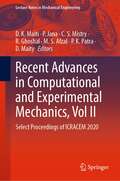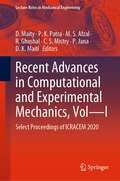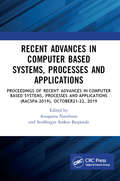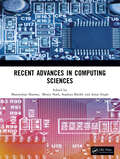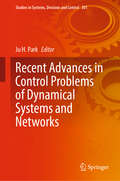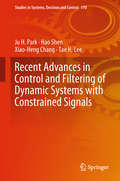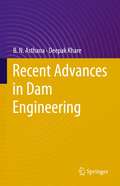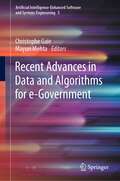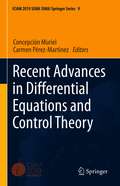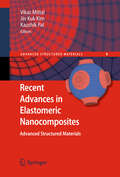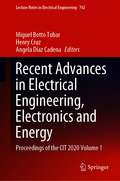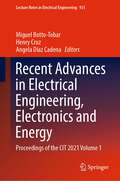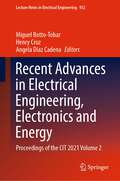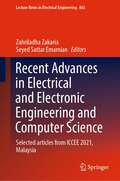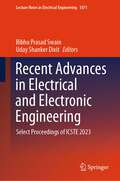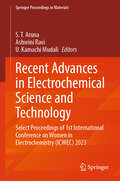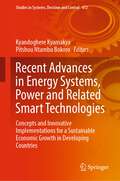- Table View
- List View
Recent Advances in Computational and Experimental Mechanics, Vol II: Select Proceedings of ICRACEM 2020 (Lecture Notes in Mechanical Engineering)
by D. Maity P. K. Patra M. S. Afzal R. Ghoshal C. S. Mistry P. Jana D. K. MaitiThis book (Vol. II) presents select proceedings of the first Online International Conference on Recent Advances in Computational and Experimental Mechanics (ICRACEM 2020) and focuses on theoretical, computational and experimental aspects of solid and fluid mechanics. Various topics covered are computational modelling of extreme events; mechanical modelling of robots; mechanics and design of cellular materials; mechanics of soft materials; mechanics of thin-film and multi-layer structures; meshfree and particle based formulations in continuum mechanics; multi-scale computations in solid mechanics, and materials; multiscale mechanics of brittle and ductile materials; topology and shape optimization techniques; acoustics including aero-acoustics and wave propagation; aerodynamics; dynamics and control in micro/nano engineering; dynamic instability and buckling; flow-induced noise and vibration; inverse problems in mechanics and system identification; measurement and analysis techniques in nonlinear dynamic systems; multibody dynamical systems and applications; nonlinear dynamics and control; stochastic mechanics; structural dynamics and earthquake engineering; structural health monitoring and damage assessment; turbomachinery noise; vibrations of continuous systems, characterization of advanced materials; damage identification and non-destructive evaluation; experimental fire mechanics and damage; experimental fluid mechanics; experimental solid mechanics; measurement in extreme environments; modal testing and dynamics; experimental hydraulics; mechanism of scour under steady and unsteady flows; vibration measurement and control; bio-inspired materials; constitutive modelling of materials; fracture mechanics; mechanics of adhesion, tribology and wear; mechanics of composite materials; mechanics of multifunctional materials; multiscale modelling of materials; phase transformations in materials; plasticity and creep in materials; fluid mechanics, computational fluid dynamics; fluid-structure interaction; free surface, moving boundary and pipe flow; hydrodynamics; multiphase flows; propulsion; internal flow physics; turbulence modelling; wave mechanics; flow through porous media; shock-boundary layer interactions; sediment transport; wave-structure interaction; reduced-order models; turbo-machinery; experimental hydraulics; mechanism of scour under steady and unsteady flows; applications of machine learning and artificial intelligence in mechanics; transport phenomena and soft computing tools in fluid mechanics. The contents of these two volumes (Volumes I and II) discusses various attributes of modern-age mechanics in various disciplines, such as aerospace, civil, mechanical, ocean engineering and naval architecture. The book will be a valuable reference for beginners, researchers, and professionals interested in solid and fluid mechanics and allied fields.
Recent Advances in Computational and Experimental Mechanics, Vol—I: Select Proceedings of ICRACEM 2020 (Lecture Notes in Mechanical Engineering)
by D. Maity P. K. Patra M. S. Afzal R. Ghoshal C. S. Mistry P. Jana D. K. MaitiThis book (Vol. - I) presents select proceedings of the first Online International Conference on Recent Advances in Computational and Experimental Mechanics (ICRACEM 2020) and focuses on theoretical, computational and experimental aspects of solid and fluid mechanics. Various topics covered are computational modelling of extreme events; mechanical modelling of robots; mechanics and design of cellular materials; mechanics of soft materials; mechanics of thin-film and multi-layer structures; meshfree and particle based formulations in continuum mechanics; multi-scale computations in solid mechanics, and materials; multiscale mechanics of brittle and ductile materials; topology and shape optimization techniques; acoustics including aero-acoustics and wave propagation; aerodynamics; dynamics and control in micro/nano engineering; dynamic instability and buckling; flow-induced noise and vibration; inverse problems in mechanics and system identification; measurement and analysis techniques in nonlinear dynamic systems; multibody dynamical systems and applications; nonlinear dynamics and control; stochastic mechanics; structural dynamics and earthquake engineering; structural health monitoring and damage assessment; turbomachinery noise; vibrations of continuous systems, characterization of advanced materials; damage identification and non-destructive evaluation; experimental fire mechanics and damage; experimental fluid mechanics; experimental solid mechanics; measurement in extreme environments; modal testing and dynamics; experimental hydraulics; mechanism of scour under steady and unsteady flows; vibration measurement and control; bio-inspired materials; constitutive modelling of materials; fracture mechanics; mechanics of adhesion, tribology and wear; mechanics of composite materials; mechanics of multifunctional materials; multiscale modelling of materials; phase transformations in materials; plasticity and creep in materials; fluid mechanics, computational fluid dynamics; fluid-structure interaction; free surface, moving boundary and pipe flow; hydrodynamics; multiphase flows; propulsion; internal flow physics; turbulence modelling; wave mechanics; flow through porous media; shock-boundary layer interactions; sediment transport; wave-structure interaction; reduced-order models; turbo-machinery; experimental hydraulics; mechanism of scour under steady and unsteady flows; applications of machine learning and artificial intelligence in mechanics; transport phenomena and soft computing tools in fluid mechanics. The contents of these two volumes (Volumes I and II) discusses various attributes of modern-age mechanics in various disciplines, such as aerospace, civil, mechanical, ocean engineering and naval architecture. The book will be a valuable reference for beginners, researchers, and professionals interested in solid and fluid mechanics and allied fields.
Recent Advances in Computer Based Systems, Processes and Applications: Proceedings of Recent Advances in Computer based Systems, Processes and Applications (NCRACSPA-2019), October21-22, 2019
by Anupama Namburu; Soubhagya Sankar BarpandaThis was the first conference organized by the school of Computer Science Engineering in VIT-AP University campus withthe cumulative efforts of all the faculty members. The proceedings discusses recent advancements and novel ideas in areas of interest. It covers topics such as advances in computer based systems, processes and applications
Recent Advances in Computing Sciences
by Amar Singh Sophiya Sheikh Manmohan Sharma Mintu NathThe 2nd International Conference on Recent Advances in Computing Sciences (RACS) was held from 29th to 30th November 2022 at Lovely Professional University, Jalandhar, India. The conference focused on discussing issues, exchanging ideas, and the most recent innovations towards advancing research in the field of Computing Sciences and Technology. All technical sessions were predominantly related to Data Science, Artificial intelligence, Remote Sensing, Image Processing, Computer Vision, Data Forensics, Cyber-Security, Computational Sciences, Simulation and modeling, Business Analytics, and Machine Learning.
Recent Advances in Control Problems of Dynamical Systems and Networks (Studies in Systems, Decision and Control #301)
by Ju H. ParkThis edited book introduces readers to new analytical techniques and controller design schemes used to solve the emerging “hottest” problems in dynamic control systems and networks. In recent years, the study of dynamic systems and networks has faced major changes and challenges with the rapid advancement of IT technology, accompanied by the 4th Industrial Revolution. Many new factors that now have to be considered, and which haven’t been addressed from control engineering perspectives to date, are naturally emerging as the systems become more complex and networked. The general scope of this book includes the modeling of the system itself and uncertainty elements, examining stability under various criteria, and controller design techniques to achieve specific control objectives in various dynamic systems and networks. In terms of traditional stability matters, this includes the following special issues: finite-time stability and stabilization, consensus/synchronization, fault-tolerant control, event-triggered control, and sampled-data control for classical linear/nonlinear systems, interconnected systems, fractional-order systems, switched systems, neural networks, and complex networks. In terms of introducing graduate students and professional researchers studying control engineering and applied mathematics to the latest research trends in the areas mentioned above, this book offers an excellent guide.
Recent Advances in Control and Filtering of Dynamic Systems with Constrained Signals (Studies in Systems, Decision and Control #170)
by Xiao-Heng Chang Ju H. Park Hao Shen Tae H. LeeThis book introduces the principle theories and applications of control and filtering problems to address emerging hot topics in feedback systems. With the development of IT technology at the core of the 4th industrial revolution, dynamic systems are becoming more sophisticated, networked, and advanced to achieve even better performance. However, this evolutionary advance in dynamic systems also leads to unavoidable constraints. In particular, such elements in control systems involve uncertainties, communication/transmission delays, external noise, sensor faults and failures, data packet dropouts, sampling and quantization errors, and switching phenomena, which have serious effects on the system’s stability and performance. This book discusses how to deal with such constraints to guarantee the system’s design objectives, focusing on real-world dynamical systems such as Markovian jump systems, networked control systems, neural networks, and complex networks, which have recently excited considerable attention. It also provides a number of practical examples to show the applicability of the presented methods and techniques. This book is of interest to graduate students, researchers and professors, as well as R&D engineers involved in control theory and applications looking to analyze dynamical systems with constraints and to synthesize various types of corresponding controllers and filters for optimal performance of feedback systems.
Recent Advances in Dam Engineering
by B.N. Asthana Deepak KhareThis book discusses recent developments in dam engineering, covering theoretical as well as practical aspects. The chapters provide detailed descriptions of the types, surveys and investigations, layouts, design, thermal stresses and foundation of dams. The differences between various theories/methods of analysis used in design and their practical application and limitations are clarified.The book focuses on earth fills and landfills and stresses the importance of the foundation treatment. Failure of embankment dams is discussed particularly in the planning and construction stages of the dam. The environmental impact of dams is treated with references to river diversions and reservoir sedimentation. The book is written as a reference book for professional engineers and is also suitable for post graduate courses.
Recent Advances in Data and Algorithms for e-Government (Artificial Intelligence-Enhanced Software and Systems Engineering #5)
by Mayuri Mehta Christophe GaieThis book presents new trends to optimize e-Government in various contexts. It aims to highlight new methods and approaches that unveil the potential of data for public services. The book also illustrates how public services can be mathematically modeled with many case studies. Then, algorithms are proposed to optimize their functioning and to better contribute to the general interest, such as education, health care, safety, security, or culture. The book also focuses on protecting citizens' personal data and obtaining their explicit consent. The book is suitable for students and academics aiming to build up their background on the usage of data and algorithms through various techniques, including artificial intelligence. The book is used as a reference book for teaching a graduate course on e-Government, Process Modeling, or Artificial Intelligence. Besides its use in academia, this book is used by civil servants of every domain and citizens who aim to understand the ongoing modernization of public services.
Recent Advances in Differential Equations and Control Theory (SEMA SIMAI Springer Series #9)
by Concepción Muriel Carmen Pérez-MartinezThis book collects the latest results and new trends in the application of mathematics to some problems in control theory, numerical simulation and differential equations. The work comprises the main results presented at a thematic minisymposium, part of the 9th International Congress on Industrial and Applied Mathematics (ICIAM 2019), held in Valencia, Spain, from 15 to 18 July 2019. The topics covered in the 6 peer-review contributions involve applications of numerical methods to real problems in oceanography and naval engineering, as well as relevant results on switching control techniques, which can have multiple applications in industrial complexes, electromechanical machines, biological systems, etc. Problems in control theory, as in most engineering problems, are modeled by differential equations, for which standard solving procedures may be insufficient. The book also includes recent geometric and analytical methods for the search of exact solutions for differential equations, which serve as essential tools for analyzing problems in many scientific disciplines.
Recent Advances in Distillery Waste Management for Environmental Safety
by Vineet Kumar Pankaj Chowdhary Maulin P ShahThe safe disposal of distillery waste into the environment, as well as its recycling and management, has become a hot topic in developing countries including India. This gross misconduct creates serious environmental and public health hazards. Thus, adequate management of waste has become a priority of environmental engineers and biotechnologists for environmental safety and sustainable development. Recent Advances in Distillery Waste Management for Environmental Safety covers specific, advanced, and updated knowledge on various developed individual and/or innovative, green, and emerging plant-microbe-based technologies’ uses for the management and recycling of distillery waste in an environmentally friendly and cost-effective manner for sustainable development. Moreover, this book provides comprehensive, state-of-the-art information on the physicochemical properties, chemical composition, and environmental risks associated with distillery waste. Furthermore, the book also discusses various existing methods and technologies; up-gradation of existing technologies; the advent of newer technologies for the treatment, processing, and disposal of distillery waste; and focus areas for further development. This broad and unique coverage allows treatment firms and regulatory authorities to determine and develop appropriate treatment strategies for site-specific problems of distillery waste remediation. Features: Provides practical solutions for the treatment and recycling of distillery waste illustrated by specific case studies Focuses on recent industry practices and preferences, along with newer approaches for wastewater treatment An instructive compilation of treatment approaches, including advanced physicochemical and integrated/sequential methods Covers biocomposting of sludge and effluent, and biodiesel production from distillery waste for recycling and sustainable development Emphasizes the relationship of metagenomics with organometallic compounds of distillery waste Discusses the role of ligninolytic enzymes and bioreactors in distillery wastewater treatment This book serves as an accessible reference to assist engineering consultants, industrial waste managers, policy makers, environmental engineers, government implementers, researchers, scientists, and a wide range of professionals responsible for regulating, monitoring, and designing industrial wastewater treatment techniques, who aspire to work on the reclamation, recycling, and management of distillery waste or wastewater pollutants for environmental safety and sustainable development.
Recent Advances in Earthquake Engineering in Europe: 16th European Conference On Earthquake Engineering-thessaloniki 2018 (Geotechnical, Geological And Earthquake Engineering Ser. #46)
by Kyriazis PitilakisThis book is a collection of invited lectures including the 5th Nicholas Ambraseys distinguished lecture, four keynote lectures and twenty-two thematic lectures presented at the 16th European Conference on Earthquake Engineering, held in Thessaloniki, Greece, in June 2018. The lectures are put into chapters written by the most prominent internationally recognized academics, scientists, engineers and researchers in Europe. They address a comprehensive collection of state-of-the-art and cutting-edge topics in earthquake engineering, engineering seismology and seismic risk assessment and management. The book is of interest to civil engineers, engineering seismologists, seismic risk managers, policymakers and consulting companies covering a wide spectrum of fields from geotechnical and structural earthquake engineering, to engineering seismology and seismic risk assessment and management. Scientists, professional engineers, researchers, civil protection policymakers and students interested in the seismic design of civil engineering structures and infrastructures, hazard and risk assessment, seismic mitigation policies and strategies, will find in this book not only the most recent advances in the state-of-the-art, but also new ideas on future earthquake engineering and resilient design of structures.Chapter 1 of this book is available open access under a CC BY 4.0 license.
Recent Advances in Edible Fats and Oils Technology: Processing, Health Implications, Economic and Environmental Impact
by Yee-Ying Lee Teck-Kim Tang Eng-Tong Phuah Oi-Ming LaiThis book is written by international experts with both academic and industrial credentials. It presents for the first time, a collection of up-to-date scientific advances in the area of edible fats and oils technology, over a span of 10 years from 2009 to the year 2019. The book covers the existing and recent advanced techniques adopted in the edible fats and oils research and touches on the processing and modification, to the traceability and sustainability issues of fats and oils. Some recent technologies like supercritical carbon dioxide, microwave, ultrasound, and enzymatic‐ assisted processes, ionic liquid, enzymatic processes, biosensor and membrane technology are presented in the book. The book aims to provide the technologists and researchers in research, development and operations in the edible fats and oils industries with critical and readily accessible information on the recent advances in the field. The book is divided into three broad sections- Fats and Oils Chemistry and Processing, Fats and Oils Modification and Health Implications, and Fats and Oils Safety, Social, Environmental and Economic Impacts. It is an extremely comprehensive and valuable resource, which serves as an essential reference for students and lipid scientists from academia or industry.
Recent Advances in Elastomeric Nanocomposites
by Vikas Mittal Jin Kuk Kim Kaushik Pal'Recent Advances in Elastomeric Nanocomposites' reviews the recent progresses in the synthesis, processing as well as applications of elastomeric nanocomposites. Elastomers are a very important class of polymer materials and the generation of their nanocomposites by the incorporation of nano-filler has led to significant enhancement of their properties and, hence, expansion of their application potential. Most of the studies related with these materials are present in the form of research papers. Here, the authors present a comprehensive text covering the whole of the subject. The book is tailored more from the applications point of view, but also provide enough introductory material for research scholars new to this field.
Recent Advances in Electrical Engineering and Control Applications
by Ivan Zelinka Mohammed Chadli Sofiane BououdenThis book of proceedings includes papers presenting the state of art in electrical engineering and control theory as well as their applications. The topics focus on classical as well as modern methods for modeling, control, identification and simulation of complex systems with applications in science and engineering. The papers were selected from the hottest topic areas, such as control and systems engineering, renewable energy, faults diagnosis--faults tolerant control, large-scale systems, fractional order systems, unconventional algorithms in control engineering, signals and communications. The control and design of complex systems dynamics, analysis and modeling of its behavior and structure is vitally important in engineering, economics and in science generally science today. Examples of such systems can be seen in the world around us and are a part of our everyday life. Application of modern methods for control, electronics, signal processing and more can be found in our mobile phones, car engines, home devices like washing machines is as well as in such advanced devices as space probes and systems for communicating with them. All these technologies are part of technological backbone of our civilization, making further research and hi-tech applications essential. The rich variety of contributions appeals to a wide audience, including researchers, students and academics.
Recent Advances in Electrical Engineering, Electronics and Energy: Proceedings of the CIT 2020 Volume 1 (Lecture Notes in Electrical Engineering #762)
by Angela Díaz Cadena Henry Cruz Miguel Botto TobarThis book constitutes the proceedings of the XV Multidisciplinary International Congress on Science and Technology (CIT 2020), held in Quito, Ecuador, on 26–30 October 2020, proudly organized by Universidad de las Fuerzas Armadas ESPE in collaboration with GDEON. CIT is an international event with a multidisciplinary approach that promotes the dissemination of advances in Science and Technology research through the presentation of keynote conferences. In CIT, theoretical, technical, or application works that are research products are presented to discuss and debate ideas, experiences, and challenges. Presenting high-quality, peer-reviewed papers, the book discusses the following topics:• Electrical and Electronic• Energy and Mechanics
Recent Advances in Electrical Engineering, Electronics and Energy: Proceedings of the CIT 2020 Volume 2 (Lecture Notes in Electrical Engineering #763)
by Angela Díaz Cadena Henry Cruz Miguel Botto TobarThis book constitutes the proceedings of the XV Multidisciplinary International Congress on Science and Technology (CIT 2020), held in Quito, Ecuador, on 26–30 October 2020, proudly organized by Universidad de las Fuerzas Armadas ESPE in collaboration with GDEON. CIT is an international event with a multidisciplinary approach that promotes the dissemination of advances in Science and Technology research through the presentation of keynote conferences. In CIT, theoretical, technical, or application works that are research products are presented to discuss and debate ideas, experiences, and challenges. Presenting high-quality, peer-reviewed papers, the book discusses the following topics:• Electrical and Electronic• Energy and Mechanics
Recent Advances in Electrical Engineering, Electronics and Energy: Proceedings of the CIT 2021 Volume 1 (Lecture Notes in Electrical Engineering #931)
by Miguel Botto-Tobar Angela Díaz Cadena Henry CruzThis book constitutes the proceedings of the XVI Multidisciplinary International Congress on Science and Technology (CIT 2021), held in Quito, Ecuador, on 14–18 June 2021, proudly organized by Universidad de las Fuerzas Armadas ESPE in collaboration with GDEON. CIT is an international event with a multidisciplinary approach that promotes the dissemination of advances in Science and Technology research through the presentation of keynote conferences. In CIT, theoretical, technical, or application works that are research products are presented to discuss and debate ideas, experiences, and challenges. Presenting high-quality, peer-reviewed papers, the book discusses the following topics:· Electrical and Electronic· Energy and Mechanics
Recent Advances in Electrical Engineering, Electronics and Energy: Proceedings of the CIT 2021 Volume 2 (Lecture Notes in Electrical Engineering #932)
by Miguel Botto-Tobar Henry Cruz Angela Diaz CadenaThis book constitutes the proceedings of the XVI Multidisciplinary International Congress on Science and Technology (CIT 2021), held in Quito, Ecuador, on 14–18 June 2021, proudly organized by Universidad de las Fuerzas Armadas ESPE in collaboration with GDEON. CIT is an international event with a multidisciplinary approach that promotes the dissemination of advances in Science and Technology research through the presentation of keynote conferences. In CIT, theoretical, technical, or application works that are research products are presented to discuss and debate ideas, experiences, and challenges. Presenting high-quality, peer-reviewed papers, the book discusses the following topics:· Electrical and Electronic· Energy and Mechanics
Recent Advances in Electrical and Electronic Engineering and Computer Science: Selected articles from ICCEE 2021, Malaysia (Lecture Notes in Electrical Engineering #865)
by Seyed Sattar Emamian Zahriladha ZakariaThis book highlights recent research works on computer science, electrical and electronic engineering which was presented virtually during the 3rd International Conference on Computer Science, Electrical & Electronic Engineering (ICCEE 2021), August 2021. Written by leading researchers and industry professionals, the papers highlight recent advances and address current issues in the respective fields.
Recent Advances in Electrical and Electronic Engineering: Select Proceedings of ICSTE 2023 (Lecture Notes in Electrical Engineering #1071)
by Uday Shanker Dixit Bibhu Prasad SwainThis book presents select proceedings of the International Conference on Science, Technology and Engineering (ICSTE 2023) related to electrical and electronic engineering. Various topics covered include neural network classification, text detection from natural scene images, speech processing systems, Wi-Fi intrusion detection, machine learning, wireless sensor network, image retrieval, automatic speech recognition, device physics, power transfer, photovoltaics, antenna for ultra-wideband applications, electric vehicles, etc. The book is useful for researchers and professionals whose work involves electrical and electronics and computer science fields.
Recent Advances in Electrical and Information Technologies for Sustainable Development: Proceedings of the 3rd International Conference on Electrical and Information Technologies — ICEIT 2017, Morocco (Advances in Science, Technology & Innovation)
by Soumia El Hani Mohamad EssaaidiThe book includes the best extended papers which were selected from the 3rd International Conference of Electrical and Information Technologies (ICEIT 2017, Morocco). The book spans two inter-related research domains which shaped modern societies, solved many of their development problems, and contributed to their unprecedented economic growth and social welfare. Selected papers are based on original and high quality research. They were peer reviewed by experts in the field. They are grouped into five parts. Part I deals with Power System and Electronics topics that include Power Electronics & Energy Conversion, Actuators & Micro/Nanotechnology, etc. Part II relates to Control Systems and their applications. Part III concerns the topic of Information Technology that basically includes Smart Grid, Information Security, Cloud Computing Distributed, Big Data, etc. Part IV discusses Telecommunications and Vehicular Technologies topics that include, Green Networking and Communications, Wireless Ad-hoc and Sensor Networks, etc. Part V covers Green Applications and Interdisciplinary topics, that include intelligent and Green Technologies for Transportation Systems, Smart Cities, etc. This book offers a good opportunity for young researchers, novice scholars and whole academic sphere to explore new trends in Electrical and information Technologies.
Recent Advances in Electrochemical Promotion of Catalysis (Modern Aspects of Electrochemistry #61)
by Constantinos G. Vayenas Philippe VernouxThis contributed volume provides a critical review of research in the field of Electrochemical Promotion of Catalysis (EPOC). It presents recent developments during the past decade that have led to a better understanding of the field and towards applications of the EPOC concept. The chapters focus on the implementation of EPOC for developing sinter-resistant catalysts, catalysts for hydrogen production, ammonia production and carbon dioxide valorization. The book also highlights the developments towards electropromoted dispersed catalysts and for self-sustained electrochemical promotion which are currently expanding. This authoritative analysis of EPOC is useful for various scientific communities working at the interface of heterogeneous catalysis, solid state electrochemistry and materials science. It is of particular interest to groups whose research focuses on developments towards a better and more sustainable future.
Recent Advances in Electrochemical Science and Technology: Select Proceedings of 1st International Conference on Women in Electrochemistry (ICWEC) 2023 (Springer Proceedings in Materials #47)
by U. Kamachi Mudali S. T. Aruna Ashwini RaviThis book presents selected proceedings of first “International Conference on Women in Electrochemistry (ICWEC-2023). The volume covers outstanding research work in the area of (i) electrochemical energy systems, such as batteries, supercapacitors, fuel cells, (ii) analytical electrochemistry: sensors and environment, (iii) applied electrochemistry: corrosion and metal/surface coatings, (iv) fundamental electrochemistry, and (v) surface engineering. This proceedings aims to motivate the contributing authors, upcoming researchers, scholars, and women in science. This unique proceedings comprises of a majority of papers contributed by women researchers that befits the focused theme of ICWEC – “Unleashing the potential of women in electrochemistry.”
Recent Advances in Energy Harvesting Technologies (River Publishers Series in Energy Sustainability and Efficiency)
by Mangey Ram Abhishek Sharma Vibhu Jately Shailendra RajputEnergy demand is continuously rising, mainly due to population growth and rapid economic development. There are substantial worries about the environmental effects of fossil fuels in addition to the uncertainties surrounding the long-term sustainability of non-renewable energy sources. Environmental safety concerns are driving an increase in the demand for renewable energy production. Numerous efforts have been paid to harvest energy from ambient sources, e.g. solar, wind, thermal, hydro, mechanical, etc. This book discusses the application of artificial intelligence (AI) for energy harvesting. The implementation of metaheuristics and AL algorithms in the field of energy harvesting system will provide a quick start for the researchers and engineers who are new to this area. Energy harvesting technologies are growing very speedily, hence it is necessary to summarize recent advances in energy harvesting methodology. Over the recent years, a considerable amount of effort has been devoted, both in industry and academia, towards the performance modelling and evaluation of energy harvesting technologies. This book is the result of a collaborative effort among different researchers in the fields of energy harvesting and artificial intelligence. Technical topics discussed in the book include: Hybrid algorithms Mechanical to electrical energy conversion Swarm intelligence MPPT technologies Polymer nanocomposites
Recent Advances in Energy Systems, Power and Related Smart Technologies: Concepts and Innovative Implementations for a Sustainable Economic Growth in Developing Countries (Studies in Systems, Decision and Control #472)
by Kyandoghere Kyamakya Pitshou Ntambu BokoroThis edited book proposes a collection of recently undertaken technical work on topics from various aspects of power engineering, energy systems as well as integrated smart technologies and related challenges. The scientific nature of the topics to be discussed in this book ranges from novel concepts to innovative implementations of smart technologies for promoting sustainable economic growth and development. Furthermore, this book substantially contributes to the relevant literature’s advancement and possibly serves as a platform for future research endeavors and publications. In addition, knowledge enrichment and expansion of power engineering and energy systems in the context of the Fourth Industrial Revolution, such as to be portrayed in this book, fundamentally appeal to researchers, power system engineers, energy specialists, data scientists, decision-makers as well as professionals involved in the various sectors that constitute the United Nations Sustainable Development Goals.
